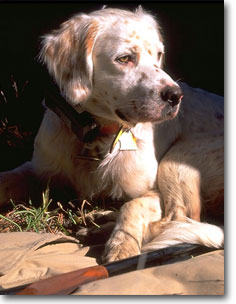 |
Chukars have legs like ballerinas, long and powerful, and prefer to run from danger, rather than flying. They are safer from predators on the ground than in the air. Conventional wisdom, which is correct in my experience, says don't hunt up towards the birds, they will just run uphill and flush at he ridge without (usually) offering a shot. Climb up and then hunt across or down the hillsides or ridge tops looking for the covey. Move at an altitude where you have heard birds calling, or have seen birds or bird sign. Watering holes and special feeding places are a good bet. Many of the brushy draws in chukar country have seeps of water and, late on dry season mornings, will be headquarters for a covey of chukars. On frosty October mornings I have found coveys of chukars out on a grassy flat, busily hunting grasshoppers, a favorite food.
Early chukar season usually begins in late September or early October and the season stretches for months, well into January. The season is roughly divided, in my mind, into the early season (before the rattlesnakes are driven underground by the frost), and the late season when the weather has cooled. By late October the birds have been hunted and shot at, so they can be skittish. If they have not been disturbed in a few days, they will hold well for a dog with decent birdwork. When flushed, they will flee, skimming down slope, around a fold in the ridge, and disappear. Or they may head down and across the canyon, sometimes flying so far that you’ll need binoculars to see where they light. If you can follow them up, hunting singles and doubles with your dog can be very productive. Remember, though, that when they alight they will typically begin moving back up slope immediately.
If you want to kill chukars consistently, you must hunt them aggressively - cover all the likely areas in a basin head or rim before moving to the next area and pursue immediately after the covey flush. Remember, when that flushed covey lights, they will be scattered and will begin to make efforts to re-assemble, calling and moving, generally up slope. By aggressively following up, you can disrupt their re-assembly and your dog can find and hold the singles and doubles.
The country that makes it so difficult to approach the birds, also makes the shooting difficult. The shooter must maintain balance and footing, no small task in rough, steep geography. Successful chukar hunters position for a line of fire, see the covey flush, and get off shots from both barrels before the birds are out of range or lost to sight. Chukars normally fly away from the hunter and sharply downward, curving right or left, following the contours of the terrain. This is a shot that cannot be learned on a skeet field and which often leaves flat land pheasant and quail hunters birdless and frustrated. Take this shot leading the bird down, with the bird visible over the barrels as it goes away and downslope.